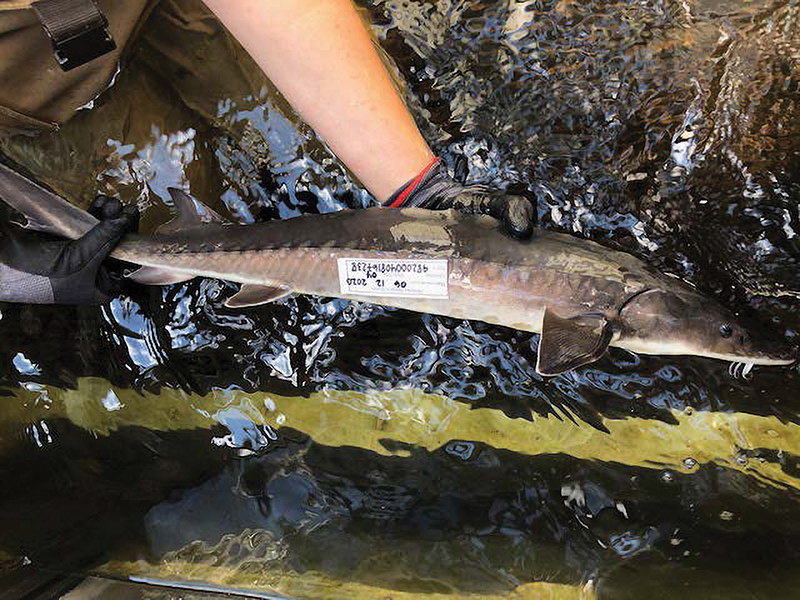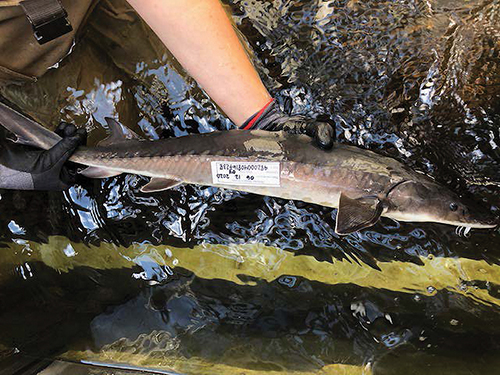Living Fossil

An adult shortnose sturgeon, a federally-listed endangered species, is inspected and documented at the Holyoke Dam Fishlift in Holyoke, Massachusetts. After inspection, the fish is released upstream in the Connecticut River.
Photo courtesy of Holyoke Gas and Electric Co. via Steve Gephard/CT DEEP
Few fish can rival the longevity or storied ancestry of shortnose sturgeon, a primitive animal that can live up to seven decades or more, and whose ancestors literally swam with the dinosaurs. “Recently, paleontologists found a fossil record, showing remnants of a mass dinosaur killing, and there were sturgeon and paddle fish carcasses, stacked together,” Micah Kieffer, a fisheries research biologist said.
Kieffer, who works with the US Geological Survey’s Silvio O. Conte Anadromous Fish Research Laboratory in Turners Falls, Massachusetts, has studied shortnose sturgeon in the Connecticut River for most of his professional life.
He is referencing a catastrophic moment in history when a massive asteroid, measuring 50 miles across, slammed into the Gulf of Mexico 66 million years ago, violently ending the dinosaur era. In the aftermath, victims like sturgeon and dinosaurs were eventually covered in silt and sand, then fossilized. But that fatal moment, for scientists like Kieffer, confirms that ancestors of shortnose sturgeon coexisted with dinosaurs.
If you compare sturgeons then and now, remarkably, there is little difference. Like their ancestors, shortnose sturgeon have a shark-like tail, a protrusive mouth on the underside of their head, and a body encased in a protective, armor-plated skin. “It would have to be a decent-sized shark or seal, both of which have pretty strong jaw capacities, to bite through it,” said Tom Savoy, a fisheries biologist with the Connecticut Department of Energy and Environmental Protection.
These ancient fish live in large freshwater rivers on the Atlantic Coast, from Canada to Georgia and can live exceptionally long lives, up to 75 years or more. Shortnose sturgeon feed on insect larvae, worms, and mollusks and can grow up to four feet long and weigh 60 pounds. According to Dr. Boyd Kynard, a retired migratory fish biologist from the Conte Lab, shortnose sturgeon are the only fish that eat freshwater mussels in the Connecticut River, keeping that abundant population in check. They play an important role in the ecology of the river, he said.
However, years of habitat loss, pollution, dredging, and overfishing have dramatically depleted shortnose sturgeon numbers, prompting officials in 1976 to declare them federally endangered. As a result, they are still on that list. Savoy estimates there are now 8,500 shortnose sturgeon in the Connecticut River, up from 1,500, 20 years ago. Other threats to sturgeons are the dams on the Connecticut River, “restricting access between upstream spawning habitat and downstream foraging habitats in the river,” the US Fish & Wildlife Service said.
Collecting data and ultimately making changes to the dams was complex and difficult for scientists, the government, and Holyoke Gas and Electric Company, owners of Holyoke Dam. Thankfully, many talented individuals from state and federal agencies, the Connecticut River Conservancy, Trout Unlimited, including students from the University of Massachusetts-Amherst persevered. They spent more than 10 years meeting to agree on a design for upstream and downstream passage for all migratory fish at Holyoke Dam, and the most recent modifications, completed in 2015, are working.
Any structural change to a hydropower dam is not an easy task. Upstream passage over the Holyoke Dam is made possible by a fish lift system, called a “fish elevator.” It was first installed in 1955 and has since been improved in 2004 and 2015. In 2015, the company reduced the size of one of two upstream entrances. This increased the water velocity and helped the fish find the entrance more readily.
For downstream passage, a gate was retrofitted to help surface dwelling and mid-to-bottom-dwelling fish pass safely through the dam. Since 2002, HG&E has spent over $35 million in fish passage and related environmental improvements, the power company said.
In recent years, however, two different philosophies have emerged on how to ensure the long-term survival of shortnose sturgeon in the Connecticut River. Some scientists believe sturgeon need to be lifted over Holyoke Dam to reach their traditional upstream spawning grounds. Others insist sturgeon spawn downstream of Holyoke and therefore fish passage here is not necessary. In fact, they think it may even be harmful to the fish.
Tom Savoy belongs to latter group. He knows he’s in the minority. “I am probably one of two people in this whole basin that’s not a big fan of what’s happening at the Holyoke Dam,” he said. Savoy acknowledges successes have been made in lifting sturgeon over the Holyoke Dam, but he says the elevator harms sturgeon, and in some cases results in mortality. The lifting strategy may put a fish that’s already in peril at greater risk, he says.
Meanwhile, scientists like Kynard and Kieffer and other agencies and organizations believe the sturgeon need to get upstream, regardless of the challenges they face at Holyoke Dam. Their research includes 20 years of studies, indicating shortnose sturgeon spawn just below Turners Falls Dam, 35 miles north of Holyoke. Because of this they want owners of the dam to regulate the release of water during the height of the sturgeon spawning season, from roughly April 15 to June 15, allowing the fish to spawn successfully. “This is a big issue that’s preventing the relicensing of Turners Falls Dam,” said Kynard, adding “Without spawning success, the whole existence of shortnose sturgeon in the river is totally endangered.”
The Turners Falls relicensing issue is still unresolved. But the commitment and dedication that individuals like Kieffer, Savoy, and Kynard, including all the other local, state and federal agencies and organizations have collectively given to protect and preserve shortnose sturgeon in the Connecticut River is stunning, and their efforts have worked. As one scientist observed, “The numbers of sturgeon in the Connecticut River may not be there yet, but the individual fish that are collected and studied are healthy and robust.”
Kynard said: “When you are able to help the federal agencies solve not just a little problem for an endangered species, but one that totally determines their long-term probability for survival, then that makes you feel pretty good.”
Bill Hobbs is a nature columnist for The Day in New London, CT. For comments, he can be reached at whobbs246@gmail.com.

